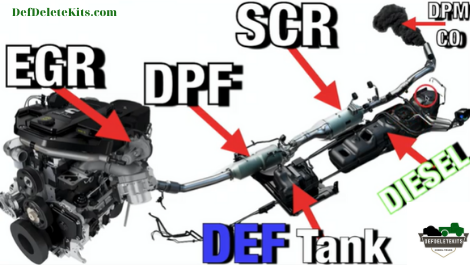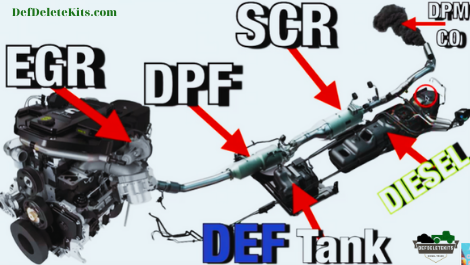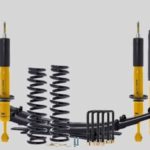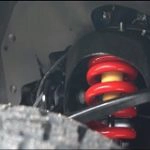THINGS TO CONSIDER BEFORE PERFORMING A DIESEL DELETE . A DPF delete, DEF refill, or EGR delete kit can be tempting for any diesel owner. Once you buy an aftermarket DPF (diesel particulate filter) delete kit, one of your biggest concerns begins to become when and where to get it serviced.
Diesel Deletes: The Difference Between DPF, DEF, and EGR Delete Kits
So what is DPF? It stands for Diesel Particulate Filter; DPFs are used by modern diesel (like the Cummins in my truck) in order to keep harmful emissions at a minimum level. DPFs actually do their job well – too well that is! Due to engine backpressure not being able to escape anywhere but through the exhaust system, they end up building up tons of ash inside the DPFs. This ash then has to be burned off periodically (about every 100-300 miles of driving; more frequently on DPF equipped diesel that drives in higher, hotter ambient temps).
DPFs can get so clogged up with this ash and other particles in the DPF filter housing, that a DPF delete is often desired by owners looking for a little extra power or fuel economy. Instead of going through all these processes about once a month, some have decided to just delete their DPFs altogether rather than deal with the cost of complete engine replacements down the road. In addition, DPFs are known to add weight and size to your engine bay over time, restricting airflow and possibly adding unnecessary stress to your engine itself.
Now onto DEF, which stands for Diesel Exhaust Fluid. DPFs are useless without a supply of DEF on board at all times. Every time you refill your DPF is when you have to top off your DEF tank. There are various sizes for DEF tanks, but most DPF equipped trucks have the five-gallon option installed on them from the factory.
DPFs are used by modern diesel (like the Cummins in my truck) in order to keep harmful emissions at a minimum level. DPFs actually do their job well – too well that is! Due to engine backpressure not being able to escape anywhere but through the exhaust system, they end up building up tons of ash inside the DPFs. This ash then has to be burned off periodically (about every 100-300 miles of driving; more frequently on DPF equipped diesel that drives in higher, hotter ambient temps).
DPFs can get so clogged up with this ash and other particles in the DPF filter housing, that a DPF delete is often desired by owners looking for a little extra power or fuel economy. Instead of going through all these processes about once a month, some have decided to just delete their DPFs altogether rather than deal with the cost of complete engine replacements down the road. In addition, DPFs are known to add weight and size to your engine bay over time, restricting airflow and possibly adding unnecessary stress on your engine itself.
Now onto DEF, which stands for Diesel Exhaust Fluid. DPFs are useless without a supply of DEF on board at all times. Every time you refill your DPF is when you have to top off your DEF tank. There are various sizes for DEF tanks, but most DPF equipped trucks have the five-gallon option installed on them from the factory.
The other difference between DPFs and EGR delete kits is that DPFs actually add horsepower to your engine while EGRs do not. In fact, an EGR delete kit often adds MPG gains because there’s less restriction in the exhaust system; however, they also take away power and make idling a little rougher (since they cool down hot exhaust gasses). DPFs typically do not make any notable difference in MPG, although it’s highly possible to see some gains with DPFs deleted.
DPF Delete Kits are often less expensive than DPF Removal or Flush Services offered by dealerships. DPFs can cost upwards of $1500+ to replace if they go bad on your vehicle, while complete DPF Delete kits range anywhere from $700-$1000 depending on the type of DPF delete kit being purchased and where you live!
Rules and Regulations on Delete Kits
DPF Delete kits are often sold as a way to bypass, disable, or remove DPFs from the exhaust system. DPF Delete kits actually combine DPF delete solenoids with DPF delete pipes and oiled magnets, all designed to override the DPF system on your truck. The unfortunate side effect is that DPFs have to be working in order for DEF to be sprayed into the DPF filter housing to prevent excess soot buildup due to design.
When a DPF Delete kit is installed, it can cause problems with emissions systems going forward if not properly mapped by a tuner. There are also several states and localities where DPFs have strictly mandated law (California being one of them) due to the DPFs ability to reduce harmful emissions. Any DPF delete kit that’s been installed would be grounds for a “smog check” failure if your vehicle ended up in a smog station.
Be sure to check with your local state laws and regulations before buying any DPF Delete kit! Although DPF Delete kits allow you to remove or override DPFs from functioning, it creates a whole new list of problems going forward. Always do research on DPFs and DPF Delete kits before considering them as an option on your truck!
Understanding the Difference: DEF, DPF, EGR Delete Kits
DPF Delete kits are a great way to remove DPFs from working, but they tend to come with a lot of legal issues going forward. DPFs also tend to increase horsepower and help MPG, making DPF Delete kits an unfortunate yet common “side effect” on vehicles. It’s best to do your research before considering a DPF Delete kit as an option for removing DPFs from the system.

In this article, I have described what EGRs, DPFs, DEFs are and how DPF deletes work by combining solenoids with delete pipes and magnets all designed to override the DPF system on your truck. As you can see there is many differences between DP, EGRs, and DPFs, DPF Delete kits are actually DPF delete solenoids combined with DPF delete pipes and oiled magnets designed to remove the DPF system on your truck. DPF Delete kits are often less expensive than DPF Removal or Flush Services offered by dealerships.
DPFs can cost upwards of $1500+ to replace if they go bad on your vehicle, while complete DPF Delete kits range anywhere from $700-$1000 depending on the type of DPF delete kit being purchased and where you live! There are always pros and cons to using EGRs vs DPFs, but in this article, I have attempted to simplify it as much as possible so the reader may understand what each part does for their truck’s performance.
In a DPF delete article written by a professional tuner he explains DPFs as ” DPFs tend to make more power on trucks that have DPFs, there is some conflicting theory on the subject but DPFs do make more power vs. not having DPFs on a truck.” In my research, I learned DPFs are quite useful and tend to increase HP and MPG which makes DPF deletes an unfortunate side effect of removing them from your vehicle.
Conclusion
If you want to increase the efficiency of your diesel engine, removing a lot of unnecessary fuel injection hardware is one way to do it. A “diesel delete” removes many emissions components from an engine and could be beneficial for those looking to improve their car’s performance without sacrificing power or gas mileage.
The benefits are clear- less weight means more acceleration and higher top speeds as well as better fuel economy overall. However, before performing a diesel deletion on your vehicle consult with a mechanic first! There may be some other modifications that need to be made in order for this process to work correctly.




